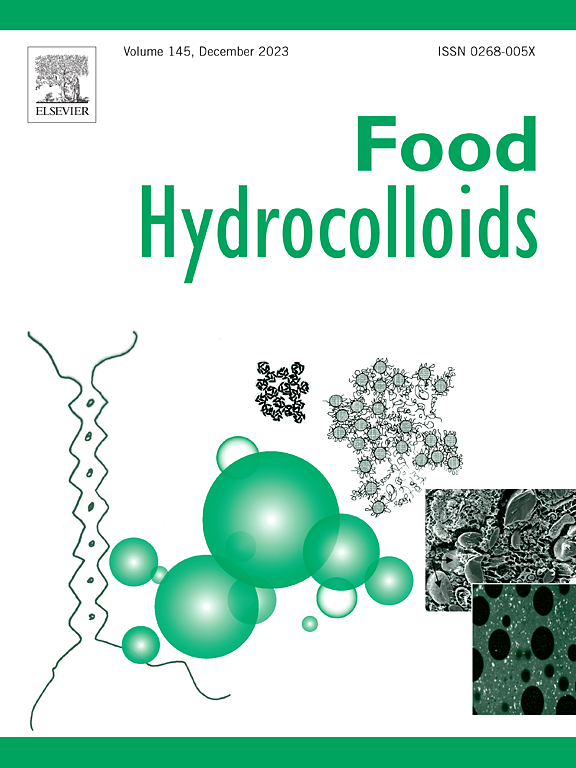Exploring the potential of the agar-based emulsion gel as a pork fat substitute in sausage with a focus on the digestive behaviors of lipids and proteins in vitro
IF 11
1区 农林科学
Q1 CHEMISTRY, APPLIED
引用次数: 0
Abstract
This study evaluated the physicochemical properties and in vitro digestion behavior of the sausages when pork back fat was replaced with a canola-oil-based emulsion gel in a pork sausage model. Three polysaccharides—agar (AG), sodium alginate (SA), and xanthan gum (XT)—were used as gelling agents, whereas isolated soy protein (ISP) and soy lecithin served as natural emulsifiers. Sausages were prepared using three treatments: conventional sausage (CS), sausage with half the pork fat replaced by an emulsion gel (RS50), and all pork fat replaced by an emulsion gel (RS100). In the meat batter incorporated with the AG-SA-XT emulsion gel, lipid droplets were uniformly dispersed into smaller sizes, resulting in reduced cooking loss (P < 0.05) and increased gel hardness (P < 0.05) in RS50 and RS100 compared with CS. Following sausage digestion in vitro, RS50 and RS100 demonstrated slower calcein release than CS (P < 0.05), whereas no significant differences in free fatty acid release were observed among the treatments (P > 0.05). The α-amino group content was higher in RS100 during the gastric phase and in both RS50 and RS100 during the intestinal phase compared to CS (P < 0.05). However, the content of proteins with molecular weight <3 kDa in the digesta showed no significant differences among treatments (P > 0.05). Consequently, adding AG-SA-XT emulsion gel as a pork fat substitute to sausages enhanced the emulsion stability and gel properties, achieved a free fatty acid release comparable to that of pork fat, and improved protein degradation.

探讨了以琼脂为基础的乳状凝胶作为猪肉脂肪替代品在香肠中的应用潜力,重点研究了脂质和蛋白质的体外消化行为
本研究在猪肠模型中,以菜籽油为基础的乳化凝胶代替猪背脂肪,评估了猪背脂肪的理化特性和体外消化行为。琼脂(AG)、海藻酸钠(SA)和黄原胶(XT)三种多糖作为胶凝剂,分离大豆蛋白(ISP)和大豆卵磷脂作为天然乳化剂。采用三种处理方法制备香肠:常规香肠(CS),用乳化凝胶(RS50)代替一半猪肉脂肪的香肠,用乳化凝胶(RS100)代替所有猪肉脂肪。在加入AG-SA-XT乳液凝胶的肉糊中,脂滴均匀分散成更小的尺寸,从而减少了蒸煮损失(P <;0.05),凝胶硬度升高(P <;0.05), RS50和RS100与CS比较。体外肠消化后,RS50和RS100的钙黄素释放速度比CS慢(P <;0.05),而各处理间游离脂肪酸释放量无显著差异(P >;0.05)。胃期RS100、肠期RS50和RS100 α-氨基含量均高于CS (P <;0.05)。然而,食糜中分子量为3 kDa的蛋白质含量在不同处理间无显著差异(P >;0.05)。因此,在香肠中添加AG-SA-XT乳凝胶作为猪肉脂肪替代品,提高了乳稳定性和凝胶性能,实现了与猪肉脂肪相当的游离脂肪酸释放,并改善了蛋白质的降解。
本文章由计算机程序翻译,如有差异,请以英文原文为准。
求助全文
约1分钟内获得全文
求助全文
来源期刊

Food Hydrocolloids
工程技术-食品科技
CiteScore
19.90
自引率
14.00%
发文量
871
审稿时长
37 days
期刊介绍:
Food Hydrocolloids publishes original and innovative research focused on the characterization, functional properties, and applications of hydrocolloid materials used in food products. These hydrocolloids, defined as polysaccharides and proteins of commercial importance, are added to control aspects such as texture, stability, rheology, and sensory properties. The research's primary emphasis should be on the hydrocolloids themselves, with thorough descriptions of their source, nature, and physicochemical characteristics. Manuscripts are expected to clearly outline specific aims and objectives, include a fundamental discussion of research findings at the molecular level, and address the significance of the results. Studies on hydrocolloids in complex formulations should concentrate on their overall properties and mechanisms of action, while simple formulation development studies may not be considered for publication.
The main areas of interest are:
-Chemical and physicochemical characterisation
Thermal properties including glass transitions and conformational changes-
Rheological properties including viscosity, viscoelastic properties and gelation behaviour-
The influence on organoleptic properties-
Interfacial properties including stabilisation of dispersions, emulsions and foams-
Film forming properties with application to edible films and active packaging-
Encapsulation and controlled release of active compounds-
The influence on health including their role as dietary fibre-
Manipulation of hydrocolloid structure and functionality through chemical, biochemical and physical processes-
New hydrocolloids and hydrocolloid sources of commercial potential.
The Journal also publishes Review articles that provide an overview of the latest developments in topics of specific interest to researchers in this field of activity.
 求助内容:
求助内容: 应助结果提醒方式:
应助结果提醒方式:


